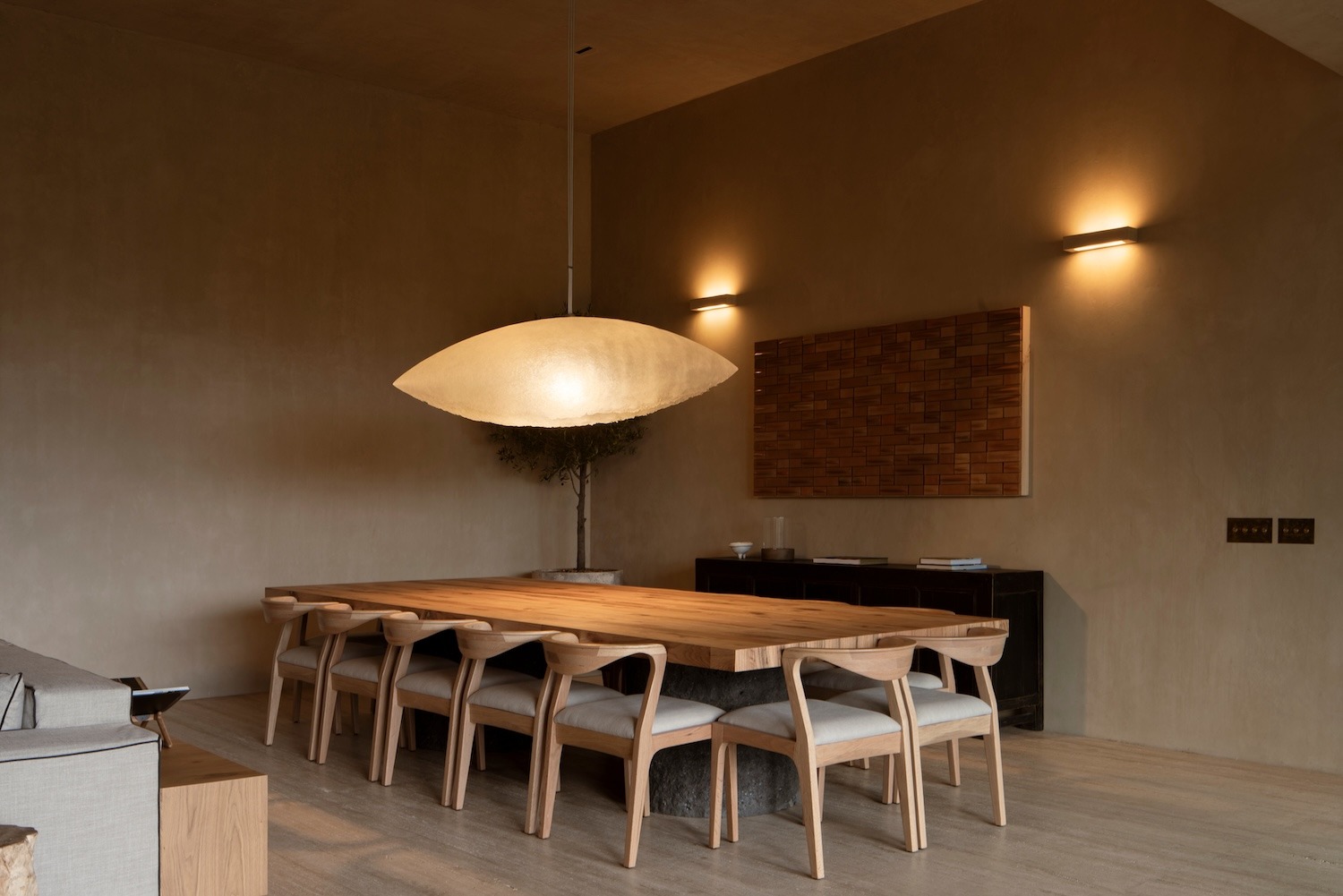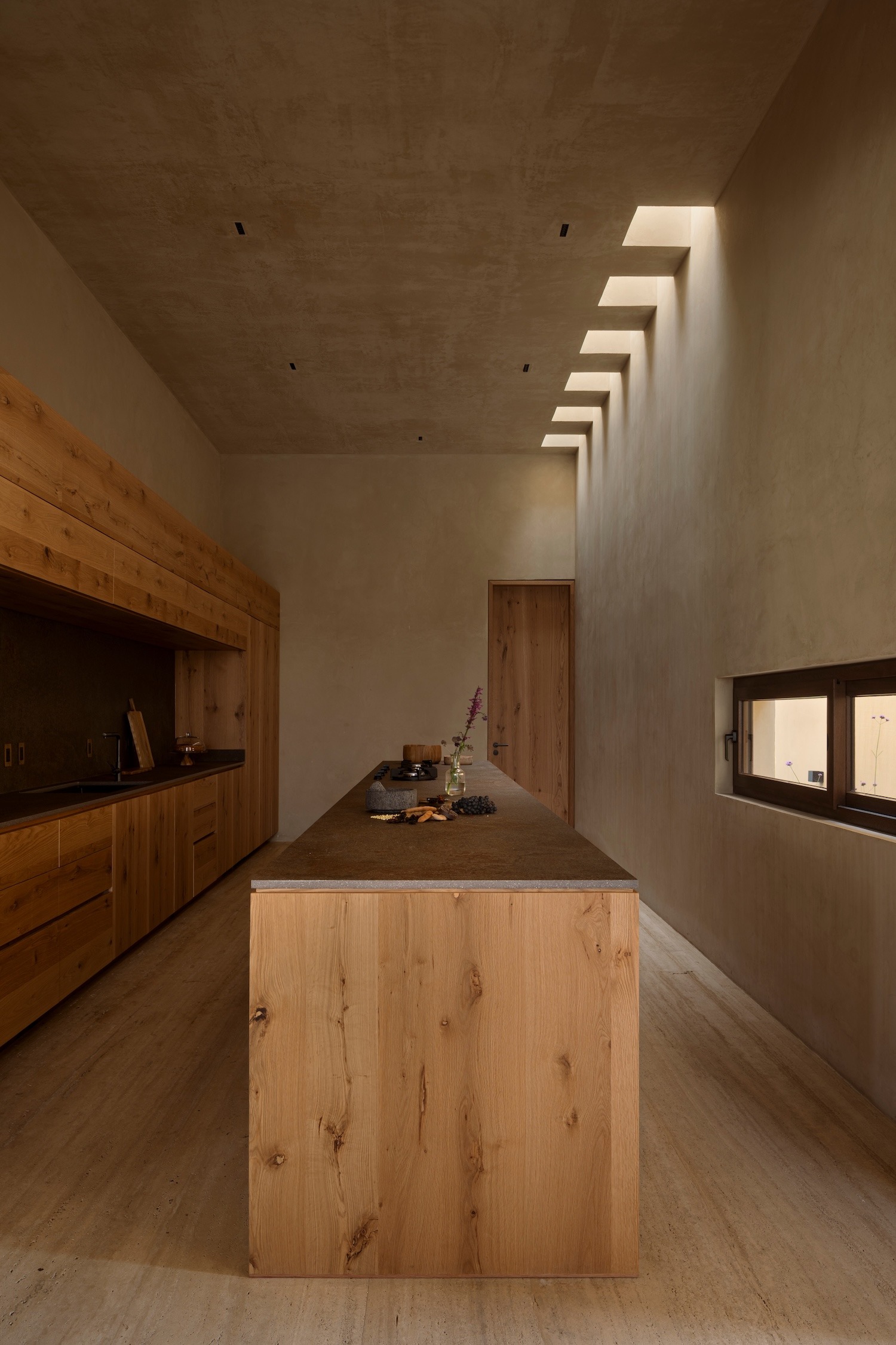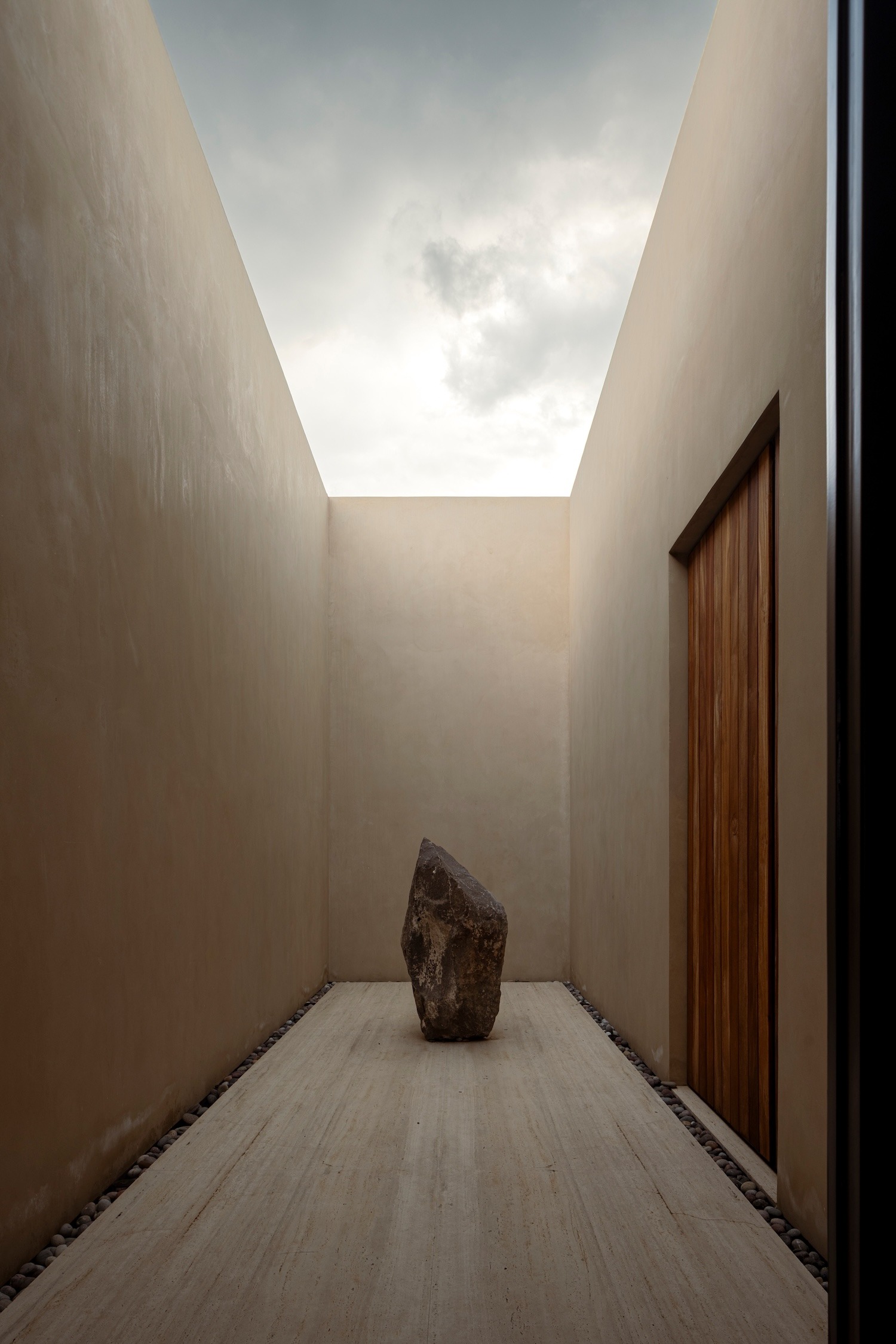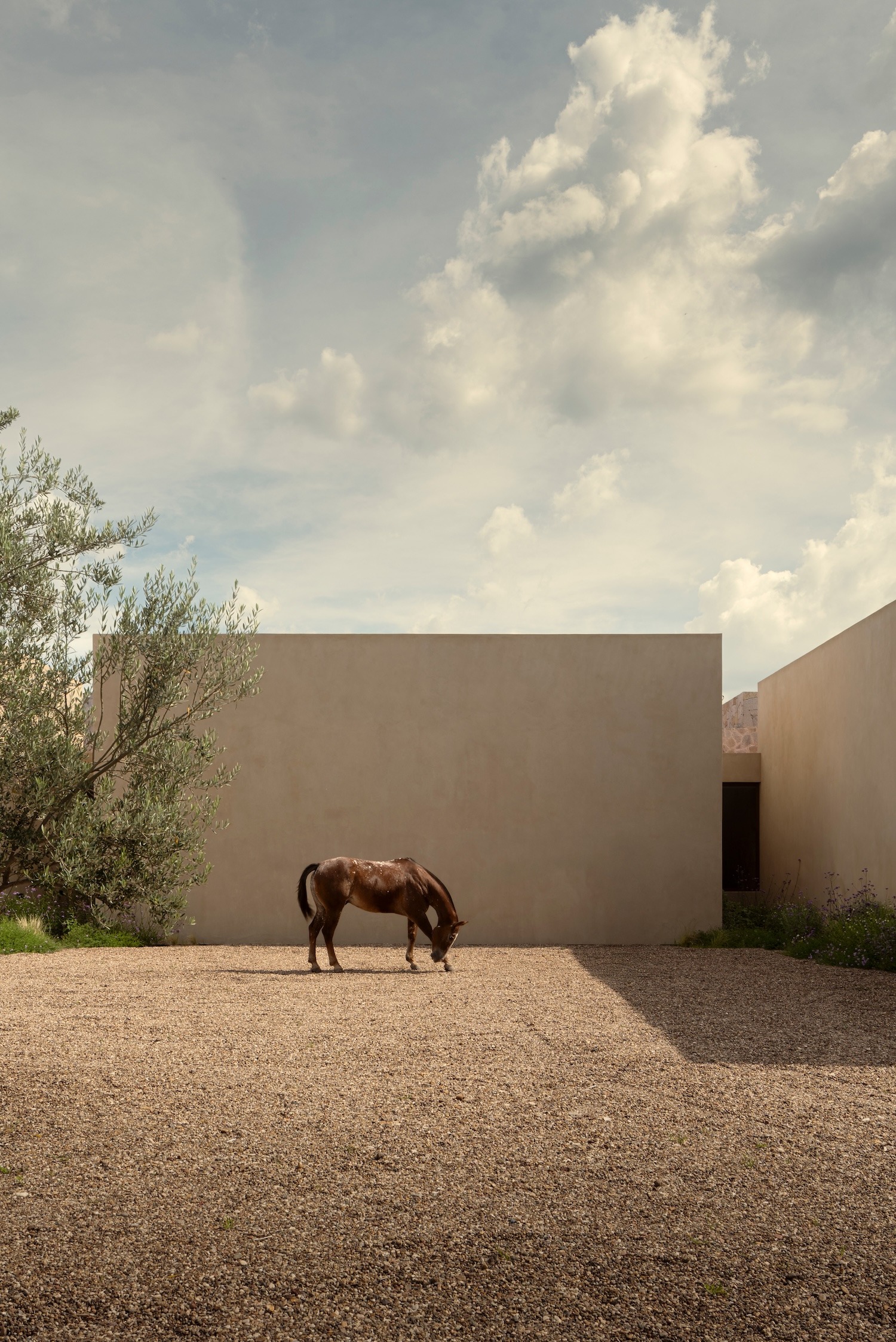"시간도 그림을 그린다. 아름다움은 시간이 지나며 불완전하게 드러난다." - 루이스 바라간 (Luis Barragán)

 |
 |
 |
시간이 그리는 건축, 카사 산 프란시스코 Jorge Garibay Architects-Casa San Francisco
Jorge Garibay Architects가 설계한 카사 산 프란시스코는 멕시코 과나후아토주의 식민지 도시 산미겔데아옌데 외곽, 포도밭 한가운데 자리한 휴양 주택이다. 이 프로젝트는 와인 제조와 수도원 건축이라는 두 가지 역사적 전통을 현대 주거 공간으로 재해석한다. 시간이라는 개념을 바탕으로 건축의 의미를 탐구한다.
16세기 프란체스코회 수도사들은 멕시코에 포도 재배를 처음 들여오면서, 가톨릭 전도 과정에서 수도원 건축도 함께 가져왔다. 포도나무와 건축, 둘 모두 지중해에서 옮겨왔고 새로운 땅에서 서로 다른 결과를 만들어냈다. 건축가는 이 둘이 멕시코라는 맥락 속에서 어떻게 변화했는지를 이 건물의 바탕으로 삼았다.
와인을 만드는 이들은 '테루아(terroir)'를 중요하게 여긴다. 기후, 토양, 고도, 그리고 인간의 경작 방식 같은 자연적 요소들이 포도주의 고유한 맛과 향에 어떻게 영향을 미치는지를 설명하는 개념이다. 건축가는 이를 건축에 적용해, 코르테스 이전 시대 멕시코 건축과는 낯선 지중해식 건축 방법이 새로운 환경과 문화 속에서 어떻게 변화하는지 살펴보았다. 이러한 비유는 건축을 보편적 해법이 아니라 특정한 환경과 문화가 만들어낸 결과로 바라보게 한다.
주변 자연과 이곳이 휴식과 명상을 위한 장소라는 점은 설계 방향을 결정했다. 건축가는 자연의 질서를 성찰하고, 성장과 변화, 쇠퇴와 엔트로피라는 계절의 순환을 바라볼 수 있는 명상의 공간을 만들고자 했다. 시간에 대한 이러한 인식은 건축을 고정된 쉼터가 아니라 자연의 순환을 관찰하는 틀로 바라보게 한다.
다섯 채의 건물은 각기 다른 조경 영역으로 열려 있으며, 포도밭과 자연 풍경을 향한 명확한 조망을 제공한다. 이들은 건물을 가로지르는 긴 복도로 연결된다. 천장이 두 배로 높은 진입 공간을 통해 들어서는 이 복도는 공용 공간이 모인 서쪽 동과 네 개의 침실이 있는 동쪽 사적 영역을 나눈다. 서쪽에는 식당, 테라스, 주방, 거실, 차고, 서비스 공간이 자리한다. 일직선으로 이어진 이 구조는 기능적 영역을 명확히 구분하면서도, 전략적으로 배치된 창을 통해 풍경을 바라볼 수 있도록 한다.
재료 전략은 최소한의 재료로 최대의 결과를 얻는다는 원칙을 따른다. 인근 부지에서 채취한 지역 석재, 광택을 내지 않은 멕시코산 대리석 바닥, 그리고 손으로 바른 석회 페인트가 석재의 자연스러운 색조를 보완하며 단색조의 거대한 형태를 만들어낸다. 오래 견디도록 선택된 이 품격 있는 재료들은 전통적인 건축 방법을 되살리면서도, 겉모습을 흉내 내지 않고 역사적 건축 기법과 대화하는 방식을 보여준다.
이는 루이스 바라간이 말한 "시간도 그림을 그린다"는 개념을 실현한다. 아름다움은 시간이 지나며 불완전하게 드러난다. 건축가는 완벽함을 추구하는 대신, 시간의 흔적이 건물에 새겨지는 과정 자체를 건축의 일부로 받아들인다. 석재 표면에 스며드는 빗물의 자국, 석회 페인트가 세월에 따라 변하는 질감, 자연광이 계절마다 다르게 그려내는 그림자. 이 모든 것이 건축물을 완성해가는 요소가 된다.
카사 산 프란시스코는 역사와 장소, 그리고 시간이라는 세 가지 축 위에 서 있다. 16세기 수도사들이 심은 포도나무처럼, 이 건축 또한 멕시코라는 땅에 뿌리내리며 고유한 정체성을 만들어간다. 그것은 완성된 오브제가 아니라, 시간과 함께 익어가는 존재다.
Write by Claude & Jean Browwn













Casa San Francisco is a minimalist residence located in San Miguel de Allende, Mexico, designed by Jorge Garibay Architects. This vacation home in a vineyard on the outskirts of the colonial Guanajuato town demonstrates how winemaking and convent architecture can inform contemporary residential design through exploration of time as conceptual framework. The project connects 16th century Franciscan friar grape cultivation introduction to Mexico with monastic architecture emergence during Catholic evangelization, treating both viticulture and construction as imports planted in new lands producing different unique results.
The terroir concept from winemaking natural factors including climate, soil, altitude, and human cultivation methods impacting wine’s unique characteristics – informs understanding of how Mediterranean construction procedures foreign to pre-Cortesian architecture were impacted by new Mexican context. This parallel between agricultural and architectural transplantation establishes philosophical foundation treating the house as response to specific environmental and cultural conditions rather than universal design solution.
The surrounding nature and property’s rest relaxation purpose influenced design goal creating contemplation space allowing reflection on natural world order and celebrating seasonal processes of growth, change, decay, and entropy. This temporal awareness positions architecture as framework for observing natural cycles rather than static shelter, reflecting broader contemporary interests in how built environments can enhance rather than obstruct environmental awareness.
Five volumes opening to different landscaped areas offer clear vineyard and natural setting views organized by transverse corridor running through volumes. The corridor accessed via double height entrance ceiling transitional space separates public west wing containing dining room, terrace, kitchen, living room, garage, and service areas from four private east-wing bedrooms. This linear organization creates clear functional zones while maintaining visual connections to landscape through strategic apertures.
The material strategy employing minimum materials for maximum results uses locally sourced stone from nearby site, unpolished Mexican marble floors, and hand-applied lime based paint complementing stone’s natural color creating monochromatic monoliths. These noble materials chosen for time endurance revive traditional construction methods demonstrating how contemporary architecture can engage historical building techniques without stylistic reproduction, supporting Luis Barragán’s notion that time also paints and beauty emerges imperfectly over time.
from leibal
'House' 카테고리의 다른 글
| * 시간의 켜를 품은 붉은 안뜰 Casa Alicia, 멕시코 코미탄 [ ALTOVA ] Alicia Hous (0) | 2025.11.12 |
|---|---|
| * 경사 위의 전망대 [ TETRO ] Casa Lua in Belo Horizonte (0) | 2025.11.04 |
| * 제약 속에서 피어난 혁신, 브리지 하우스 [ Wallmakers ] Bridge House (1) | 2025.10.31 |
| * 쉐베이 주택: 골목 안 콘크리트 볼트가 만드는 수직 풍경 [ Gonghe Construction Architectural Studio ] Xuebei Home (0) | 2025.10.28 |
| * 15제곱미터의 풍요로움 파리 지붕 아래 [ IN SINU Architectes ] Studio Marthe (0) | 2025.10.22 |